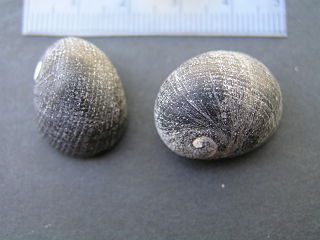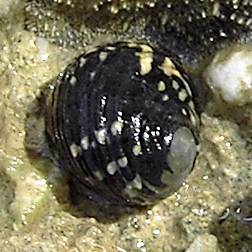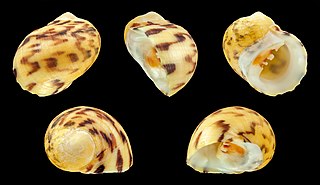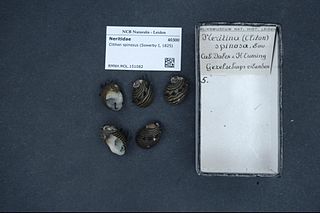
Gastropods, commonly known as slugs and snails, belong to a large taxonomic class of invertebrates within the phylum Mollusca called Gastropoda.

Nerita atramentosa, common name the black nerite, is a medium-sized sea snail, a marine gastropod mollusc in the family Neritidae, the nerites.

Neritidae, common name the nerites, is a taxonomic family of small to medium-sized saltwater and freshwater snails which have a gill and a distinctive operculum. The family Neritidae includes marine genera such as Nerita, marine and freshwater genera such as Neritina, and freshwater and brackish water genera such as Theodoxus.

Nerita is a genus of medium-sized to small sea snails with a gill and an operculum, marine gastropod molluscs in the subfamily Neritinae of the family Neritidae, the nerites.

Nerita tessellata, sometimes known as the checkered nerite, is a species of tropical sea snail with a gill and an operculum, a nerite, a marine gastropod mollusk in the family Neritidae, the nerites.

Vetigastropoda is a major taxonomic group of sea snails, marine gastropod mollusks that form a very ancient lineage. Taxonomically the Vetigastropoda are sometimes treated as an order, although they are treated as an unranked clade in Bouchet and Rocroi, 2005.

Neritimorpha is a clade of gastropod molluscs that contains around 2,000 extant species of sea snails, limpets, freshwater snails, land snails and slugs. This clade used to be known as the superorder Neritopsina.

Nerita plicata is a species of tropical sea snail, a marine gastropod mollusk in the family Neritidae, the nerites. This species is found throughout the Indo-West Pacific.

Lottia digitalis, commonly known as the fingered limpet or ribbed limpet, is a species of sea snail, a true limpet, a marine gastropod mollusk in the family Lottiidae. These limpets are usually found on the surface of rocks in the high intertidal region on the coastal fringes of the north-eastern Pacific Ocean.

Monodonta labio, common name the toothed top shell or the lipped periwinkle, is a species of sea snail, a marine gastropod mollusk in the family Trochidae, the top snails.

Nerita albicilla, common name the blotched nerite, is a species of sea snail, a marine gastropod mollusk in the family Neritidae.

Nerita chamaeleon is a species of sea snail, a marine gastropod mollusk in the family Neritidae.

Nerita peloronta, common name the "bleeding tooth", is a species of sea snail, a marine gastropod mollusc in the family Neritidae.

Nerita textilis, common name the textile nerite, is a species of sea snail, a marine gastropod mollusk in the family Neritidae.
Thalassonerita is a monotypic genus of sea snails, marine gastropod mollusks in the family Neritidae. Its sole species is Thalassonerita naticoidea. T. naticoidea is endemic to underwater cold seeps in the northern Gulf of Mexico and in the Caribbean. Originally classified as Bathynerita, the genus was reassessed in 2019 after Thalassonerita was found to be a senior synonym of Bathynerita.

Phorcus punctulatus, common name the punctate monodont, is a species of sea snail, a marine gastropod mollusk in the family Trochidae, the top snails.

Phorcus sauciatus is a species of sea snail, a marine gastropod mollusk in the family Trochidae, the top snails. It is native to the Eastern North Atlantic Ocean off the coast of Macaronesia and the Iberian Peninsula.

Neritodryas is a genus of freshwater snails, ; they are gastropod molluscs in the family Neritidae, the nerites.

Clithon spinosum is a species of brackish water and freshwater snail with an operculum, a nerite. It is an aquatic gastropod mollusk in the family Neritidae, the nerites.

Nerita Picea, also called Black Nerite or Pipipi in Hawaiian, is a species of marine gastropod mollusc in the family Neritidae commonly found in clusters on the high part of the intertidal zone. This species is found all throughout the Hawaiian coastline and is endemic to the Hawaiian Islands. In Hawai‘i black nerite are enjoyed as a snack when boiled.




















